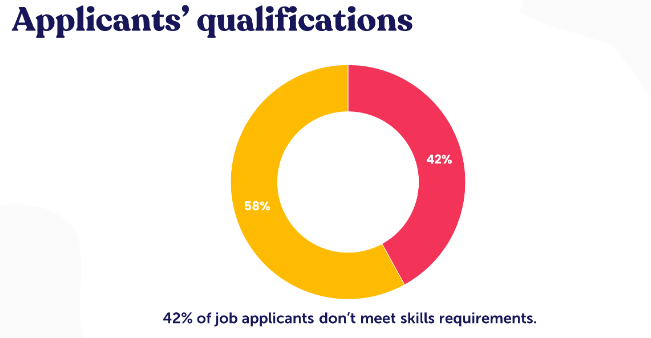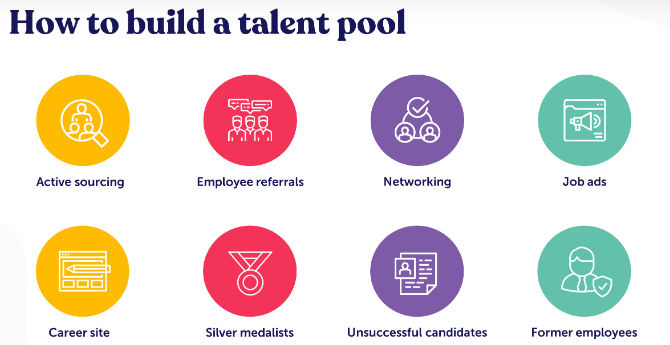Why You Need to Have a Talent Pool and How to Build One
Reading Time:
Reading Time:

In today's fiercely competitive job market, identifying and attracting top-notch candidates poses unprecedented challenges. With a myriad of considerations—from skill sets and credentials to personality traits and professional integrity—achieving the ideal match that resonates with your company's ethos and objectives can seem overwhelming. Effective document management plays a crucial role in this process, ensuring streamlined handling of candidate records, enhancing compliance, and supporting seamless decision-making throughout the recruitment journey.
This is where a talent pool comes in. In this article, we will explore the benefits of building talent pools, strategies for creating and maintaining one, and how to effectively use them to hire the best talent for your organization. Whether you are a business owner or an HR professional, understanding the value of talent pools and how to build one can help you stay ahead of the competition and ensure long-term success.
A talent pool is a group of job candidates who have been identified as having the skills, experience, and potential to fill future vacancies. These candidates may have applied for a position previously or have been identified through other means (more on that later), such as networking events or social media. The talent pool is essentially a database of qualified candidates that a company can draw from when a position becomes available.
Imagine there is an opening for a specific role at your company. Normally, you would have to start a recruitment process for a new hire – posting ads, screening tens or hundreds of applicants, and conducting a lot of interviews to find the right fit for your team. But what if you already had a detailed list of high-quality candidates that fit your needs well and all you had to do was choose the right one? It is pretty clear how having a database of high-quality candidates ready at hand can provide you with several important benefits.
By maintaining a talent pool, you have a pool of potential candidates who have already expressed interest in your company and have undergone some level of screening. This means that when a position becomes available, you can simply reach out to your pool rather than starting the entire hiring process from scratch. This saves time and money on recruiting, screening, and interviewing.
Finding the right candidate for a role within your company is no easy task. Especially if it is a more critical and demanding role. Being able to choose from a pool of high-quality candidates who are likely to be a good fit for your company enables you to make a more informed decision and makes the whole process easier.
By building a talent pool, you can take your time to identify the most qualified candidates who are the best fit for your organization's culture and needs. This means that when you do make a hire, you can be confident that you've found the right person for the job.

No organization is immune to staffing needs, whether due to growth, turnover, or unexpected events. By having a talent pool, you can ensure that you're always prepared for these situations and can quickly fill any gaps in your workforce.
By having a talent pool, you can develop a relationship with potential candidates over time, keeping them engaged and interested in your company. This can help you to build a talent pipeline that is more likely to stay with your company long-term. However, engaging with the candidates from the pool and keeping them interested is not just good for retention but for your overall employer branding and reputation. We’ll get more into that in the next section.
By now, you’ve probably realized all the benefits of talent pooling and how it can help your hiring. Now, let’s take a look at the process of building and maintaining an effective talent pool that will help you in the long run. The whole process can be divided into four stages.
How do you start building a talent pool from scratch? Well, there are numerous ways you can find candidates to add to your pool and keep in your database for future opportunities.

By combining these methods, you can build a diverse pool of qualified individuals who may be interested in future opportunities and would make a good fit for your organization.
Once you’ve gathered an extensive number of candidates to your pool, you want to segment it based on different factors so that it would be easier to target specific groups of candidates when you have job openings that match their skills and experience.
You can segment your talent pool based on factors such as skills, experience, location, education, interests, referral sources, and others. This will make it easier to form groups of candidates with common characteristics, depending on the vacancy that you need to fill.
By segmenting your pool, you can communicate with candidates more effectively and target them with job opportunities that match their skills, experience, and interests. This can help improve candidate experience, build stronger relationships with potential candidates, and increase your chances of hiring the best candidates for your open positions. That leads us to the next stage in building and maintaining a well-developed talent pool.
Ok, you’ve pooled many talented individuals that have the potential to become a part of your workforce and you’ve segmented the pool based on different factors. But what now? Do you just keep them waiting there for the next opportunity to come up? Of course not. You have to engage with them to keep them interested in what you have to offer and establish a connection.
Engaging with candidates is a crucial part of building and maintaining talent pools. It means keeping in touch with them over time, even when you don't have an immediate job opening that matches their skills and experience. That way you keep them interested in your company and build stronger relationships with them over time which can help you to attract top talent when you have openings that match their expertise.
Here are some ways to engage with the talent from your pool:
Engaging with candidates in these ways can help you build a positive reputation as an employer and attract top talent to your organization. By showing that you value and invest in your talent pool, you can develop a strong network of candidates who are interested in working for your company.
Keep your talent pool up to date by regularly reviewing it, adding new suitable candidates, and removing those who are no longer interested or no longer meet your criteria. Also, evaluating and refining your talent pool strategy to ensure that it is effective in attracting and retaining top talent is important.
You can evaluate your talent pool effectiveness by tracking metrics such as the number of candidates in your talent pool, the quality of hires, and time-to-hire and analyze data on candidate engagement, communication channels, and segmentation to identify areas for improvement.
Having a well-structured talent pool is a strategic imperative for organizations looking to optimize their recruitment and secure the best talent for their teams. But starting to build talent pools from scratch is a challenging task.
While you can try to manually build and manage your pool, it could require a lot of effort and time. And even though you know how incredibly useful a talent pool could be, being swamped with all the other recruiting tasks, manually building and keeping track of a talent pool might seem like a lot of extra work.
Luckily, leveraging software like IceHrm, it can be done easily. IceHrm makes building and maintaining a talent pool much more manageable and streamlined as it allows you to automate and keep track of the whole process in one place:
IceHrm provides you with everything you need to build talent pools from start to finish, help your recruitment process and be more efficient and effective in attracting and retaining top talent.
Keep in mind that building talent pools is an ongoing process that requires effort and investment. But in the end, it leads to a stronger employer brand, improved hiring outcomes, and a competitive edge in the talent market, making it an essential part of any organization's talent acquisition strategy.